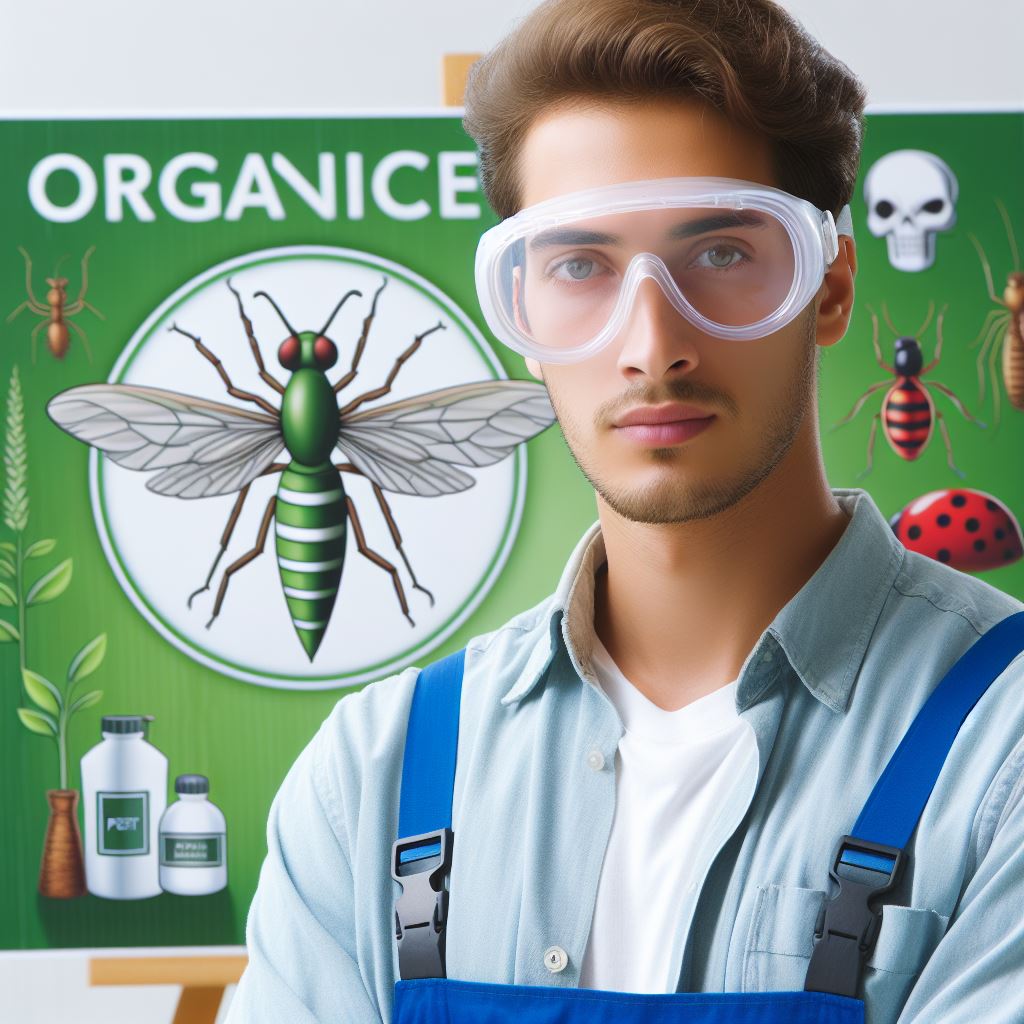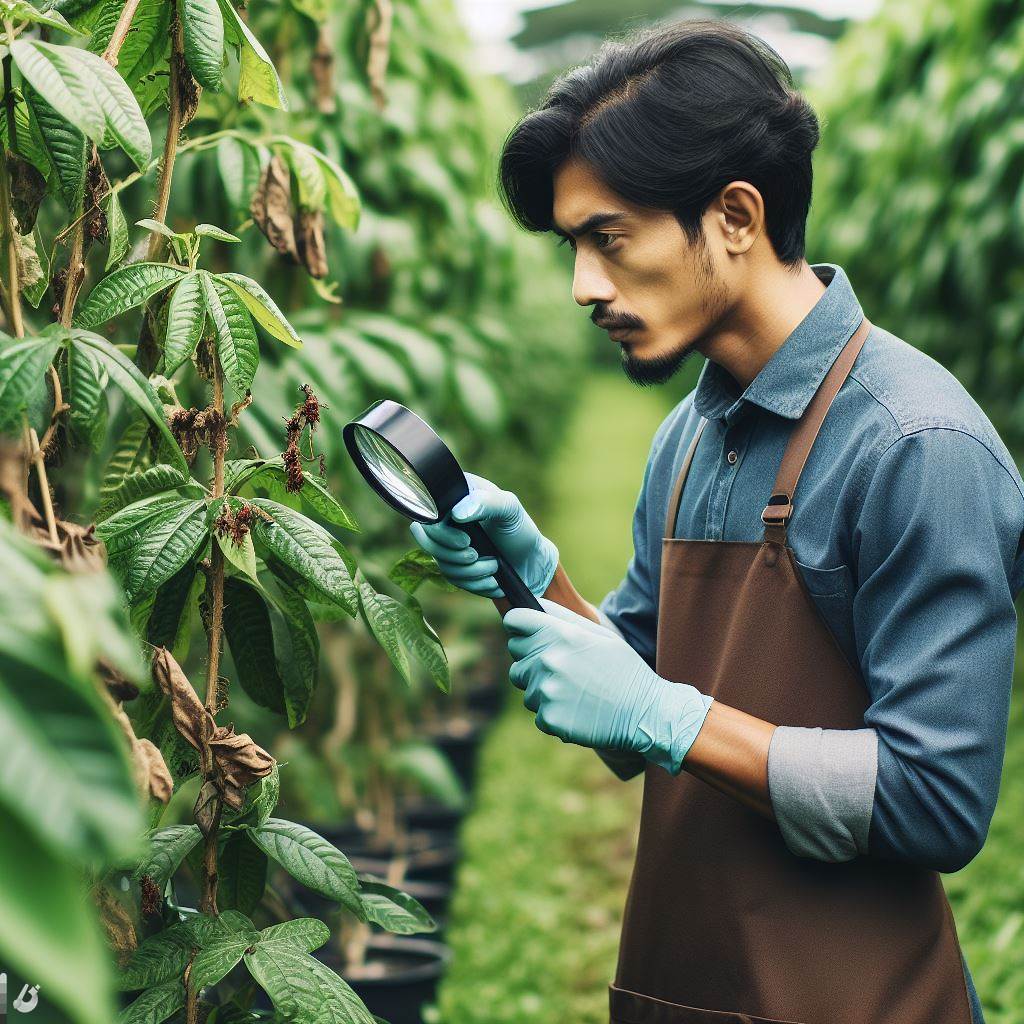Introduction
IPM strategies are essential for tackling pest issues in agriculture while safeguarding the environment.
By integrating various methods such as biological control, cultural practices, and monitoring, IPM minimizes the use of chemical pesticides, ensuring a safer environment for both humans and wildlife.
Biological control, for instance, relies on natural enemies like predators, parasites, and pathogens to control pests instead of relying solely on chemicals.
This approach helps maintain a balanced ecosystem and protects beneficial organisms.
Cultural practices, another key aspect of IPM, involve creating conditions unfavorable to pests while promoting healthy plant growth.
Crop rotation, sanitation, and proper irrigation techniques are examples of this strategy.
Regular monitoring and scouting are crucial components of IPM.
By continually assessing pest populations and damage levels, farmers can determine the most appropriate management actions, reducing the unnecessary use of pesticides.
IPM also emphasizes the use of selective and less toxic pesticides as a last resort, ensuring minimal harm to non-target organisms and the environment.
In short, IPM strategies provide a sustainable and environmentally friendly approach to pest management in agriculture.
By implementing these integrated strategies, farmers can effectively control pests while preserving the health of ecosystems and safeguarding the well-being of future generations.
The Concept of IPM
Explanation of the basic concept of IPM
The concept of Integrated Pest Management (IPM) is a proactive and holistic approach to managing pests in an environmentally safe and effective manner.
IPM aims to minimize the reliance on chemical pesticides by utilizing a combination of methods to prevent and control pest infestations.
This approach focuses on long-term solutions rather than quick fixes, taking into consideration the ecological balance and overall health of the environment.
Key principles of IPM
- Pest identification and monitoring: The first step in IPM is accurately identifying the pests and monitoring their population levels.
- Prevention and cultural practices: IPM emphasizes the use of preventive measures and cultural practices to create a less favorable environment for pests.
- Biological control methods: IPM utilizes natural mechanisms, such as predators, parasites, and pathogens, to control pest populations.
- Proper use of chemical pesticides: When necessary, the judicious and strategic use of chemical pesticides is recommended as a last resort and in accordance with regulations and safety guidelines.
Understanding and implementing these key principles of IPM can lead to sustainable pest management practices that are both effective and safe for the environment.
Transform Your Agribusiness
Unlock your farm's potential with expert advice tailored to your needs. Get actionable steps that drive real results.
Get StartedBy using IPM strategies, growers and pest management professionals can reduce the potential risks associated with excessive chemical use, protect beneficial organisms, and safeguard the ecosystem.
Furthermore, IPM promotes a proactive rather than reactive approach to pest management, resulting in long-term cost savings for farmers and a healthier environment for all.
The concept of IPM is not limited to agricultural settings; it can also be applied to urban pest management, such as controlling pests in homes, schools, and public spaces.
Overall, IPM is a comprehensive and sustainable approach that takes into account the diverse factors impacting pest populations while prioritizing the safety of the environment and public health.
By integrating multiple pest management strategies and making informed decisions, IPM provides a framework for effective, eco-friendly, and long-lasting pest control.
Read: Understanding IPM in Sustainable Farming
Benefits of IPM Strategies
Reduced reliance on chemical pesticides
Using IPM strategies can significantly reduce the reliance on chemical pesticides.
With IPM, farmers can employ a combination of tactics such as crop rotation, biological controls, and habitat manipulation to manage pests.
This approach minimizes the need for chemical pesticides, which can be harmful to the environment and human health.
Protection of natural ecosystems and biodiversity
IPM strategies prioritize the protection of natural ecosystems and the preservation of biodiversity.
By using less chemical pesticides, IPM helps mitigate the negative impact on beneficial insects such as bees and butterflies.
These beneficial insects play a crucial role in pollination and maintaining a healthy ecosystem.
IPM also takes into account the ecological interactions between pests, their natural enemies, and the environment.
This holistic approach ensures the overall well-being of the ecosystem.
Preservation of soil health and fertility
An important benefit of IPM strategies is the preservation of soil health and fertility.
Chemical pesticides can negatively affect the microorganisms and beneficial insects present in the soil.
These organisms play a vital role in maintaining nutrient cycling and soil structure.
By reducing pesticide use, IPM promotes the growth of beneficial organisms and improves soil health.
This, in turn, leads to better crop yields and sustainable farming practices.
Improved water and air quality
Implementing IPM strategies contributes to improved water and air quality.
Chemical pesticides can contaminate surface and groundwater, posing a threat to aquatic ecosystems.
With reduced pesticide use, IPM reduces the risk of water pollution and protects aquatic life.
Additionally, pesticide drift, which can harm human health, is also minimized with IPM.
This ensures cleaner air and a healthier environment for both humans and wildlife.
Showcase Your Farming Business
Publish your professional farming services profile on our blog for a one-time fee of $200 and reach a dedicated audience of farmers and agribusiness owners.
Publish Your ProfileSafer working conditions for farmers
Adopting IPM strategies results in safer working conditions for farmers.
Pesticide exposure is a major health concern for farmers who frequently handle and apply these chemicals.
With IPM, farmers can minimize their direct contact with chemical pesticides by relying on alternative pest management methods.
This reduces the risk of pesticide-related illnesses and promotes the well-being of farmers.
Furthermore, IPM encourages proper safety practices and emphasizes the use of personal protective equipment when necessary.
In fact, IPM strategies offer a range of benefits that are safe for the environment.
With reduced reliance on chemical pesticides, IPM protects natural ecosystems, preserves soil health and fertility, and improves water and air quality.
Additionally, IPM provides safer working conditions for farmers, promoting their well-being.
By implementing IPM strategies, we can ensure sustainable and environmentally-friendly agricultural practices for a healthier planet.
Read: Organic IPM Solutions for Healthy Crops
IPM Strategies and the Environment
Integrating integrated pest management (IPM) strategies into agricultural practices has become increasingly important in recent years.
The use of IPM strategies not only ensures effective pest management but also promotes environmental safety.
In this section, we will discuss how IPM strategies can be safe for the environment, focusing on the use of natural pest enemies, crop rotation and intercropping, as well as trap crops and pheromone traps.
Use of natural pest enemies
Introduction to beneficial insects and animals
Beneficial insects and animals, such as ladybugs, lacewings, and birds, play a crucial role in controlling pest populations naturally.
These allies in pest control are often overlooked but can significantly reduce the need for chemical pesticides.
Encouraging their presence in the ecosystem
To promote the presence of beneficial insects and animals, farmers can provide appropriate habitats, such as wildflower strips, hedgerows, and insect hotels.
These habitats offer shelter, food, and breeding sites, creating a balanced ecosystem where pests are kept under control naturally.
Crop rotation and intercropping
Explanation of how these practices help reduce pests
Crop rotation involves alternating the types of crops grown in specific fields over several seasons.
This practice helps disrupt pest life cycles by preventing the buildup of pests that specifically target certain crops.
Intercropping, on the other hand, involves planting different crops in close proximity to create a diverse and confusing environment for pests, making it difficult for them to locate and feed on their preferred host plants.
Benefits for soil health and overall plant growth
In addition to pest control, crop rotation and intercropping offer several benefits for soil health and overall plant growth.
Different crops have different nutrient requirements, and rotating them helps prevent nutrient depletion and improve soil fertility.
Intercropping can also enhance nutrient cycling and reduce soil erosion, promoting sustainable agriculture practices.
Trap crops and pheromone traps
Description of how these strategies work
Trap crops are sacrificial plants that are highly attractive to pests, diverting their attention from the main crop.
By offering an alternative food source, trap crops effectively lure pests away and protect the primary crop from damage.
Pheromone traps, on the other hand, use synthetic versions of insect sex pheromones to attract and trap pests.
These traps disrupt the mating cycle of pests, reducing their population.
Reducing pest population without harming other crops
The use of trap crops and pheromone traps allows farmers to specifically target pests without harming beneficial insects and other crops.
This targeted approach is not only environmentally friendly but also cost-effective and reduces the reliance on chemical pesticides, which can have negative impacts on the environment, wildlife, and human health.
In essence, implementing IPM strategies that focus on natural pest enemies, crop rotation and intercropping, as well as trap crops and pheromone traps, can provide effective pest management while safeguarding the environment.
By adopting these practices, farmers can reduce their ecological footprint, promote biodiversity, and contribute to sustainable and responsible agricultural practices.
Read: IPM: Balancing Nature & Agriculture Sustainably

Case Studies of Successful IPM Implementation
Example 1: Organic farms and their use of IPM strategies
Organic farming prioritizes sustainability and ecological balance, emphasizing natural practices over synthetic inputs.
IPM seamlessly integrates with organic principles, enhancing environmental safety.
Explanation of organic farming principles
- Emphasis on biodiversity to control pests naturally.
- Avoidance of synthetic pesticides and chemical fertilizers.
- Soil health improvement through organic amendments.
How IPM aligns with organic farming practices
- Predatory insects as biological controls.
- Crop rotation and diversification for pest disruption.
- Monitoring and early intervention, reducing the need for chemical solutions.
Example 2: IPM adoption in large-scale agricultural systems
Large-scale agriculture faces unique challenges, requiring efficient, sustainable, and cost-effective solutions.
IPM initiatives have proven instrumental in transforming commercial farming practices positively.
Introduction of IPM Initiatives in Commercial Farming
- Integrated pest monitoring using advanced technologies.
- Strategic use of pheromones and traps for pest control.
- Implementation of resistant crop varieties to minimize susceptibility.
Positive Results and Impact on Crop Production
- Increased yields due to targeted pest management.
- Reduced reliance on chemical inputs, lowering environmental impact.
- Enhanced soil and ecosystem health through integrated practices.
In brief, as we delve into these case studies, it becomes evident that IPM is not just a theoretical concept but a practical and successful approach to sustainable agriculture.
Organic farms showcase how embracing biodiversity and natural processes can effectively control pests without compromising yields.
Similarly, in large-scale agricultural systems, the adoption of IPM strategies proves transformative, offering a blueprint for the future of eco-friendly farming.
By actively implementing IPM, farmers can safeguard the environment, ensuring the longevity of agricultural practices.
Showcase Your Farming Business
Publish your professional farming services profile on our blog for a one-time fee of $200 and reach a dedicated audience of farmers and agribusiness owners.
Publish Your ProfileThese case studies serve as beacons of hope, illustrating that with careful planning and adherence to IPM principles, we can strike a harmonious balance between productivity and environmental responsibility in our pursuit of safe and sustainable agriculture.
Read: Eco-Friendly IPM Techniques in Modern Farms
Challenges and Future of IPM Strategies
In the realm of sustainable agriculture, Integrated Pest Management (IPM) stands as a beacon, championing eco-friendly practices.
Despite its significant successes, IPM does encounter hurdles that demand attention and innovation for a flourishing future.
Limitations and obstacles faced in implementing IPM
- Resistance Concerns: Pests can develop resistance to certain control methods over time, challenging the effectiveness of IPM.
- Knowledge Disparities: Farmers may lack access to information and training on IPM strategies, hindering their implementation.
- Economic Constraints: Initial investment in IPM infrastructure may be a barrier for small-scale farmers, affecting widespread adoption.
- Monitoring Challenges: Continuous monitoring of pest populations demands resources and time, posing logistical challenges for farmers.
Need for research and innovation in IPM strategies
- Adaptive Management: Implementing flexible strategies allows for adjustments based on evolving pest dynamics and environmental changes.
- Biopesticides Development: Ongoing research to enhance the efficacy and application of biopesticides contributes to safer pest control methods.
- Education Initiatives: Promoting awareness and education programs equips farmers with the knowledge needed for successful IPM implementation.
- Policy Support: Governments play a crucial role in incentivizing IPM adoption through policies that support sustainable agricultural practices.
Potential advancements and technologies to enhance IPM effectiveness
- Precision Agriculture: Integration of technology enables targeted application of pest control measures, minimizing environmental impact.
- Remote Sensing Tools: Satellite imagery and drones assist in real-time monitoring, aiding farmers in timely and accurate decision-making.
- Biological Control Innovations: Continuous exploration of new predator-prey relationships enhances the arsenal of biological control methods within IPM.
- Data Analytics: Harnessing big data helps in predicting pest outbreaks, optimizing resource allocation, and improving the overall efficiency of IPM.
As we confront these challenges head-on, it’s essential to recognize the immense potential for growth within IPM strategies.
The need for collaboration between researchers, policymakers, and farmers is evident.
By addressing limitations, investing in research, and embracing technological innovations, the future of IPM holds promise for sustainable and environmentally conscious agriculture.
The journey towards a greener tomorrow involves not just overcoming obstacles but also embracing the continuous evolution of IPM strategies.
Conclusion
IPM strategies offer numerous benefits for the environment. By reducing the reliance on harmful pesticides, IPM promotes a healthier ecosystem.
It minimizes the negative impact on non-target organisms, such as beneficial insects, birds, and mammals.
Additionally, IPM helps prevent water and air pollution by minimizing pesticide runoff and drift.
Farmers and policymakers should strongly consider adopting IPM practices.
Not only do these strategies protect the environment, but they also provide long-term economic benefits. By reducing pesticide use, farmers can save on input costs.
Furthermore, IPM can lead to higher crop yields, as it includes a holistic approach to pest management.
The importance of sustainable agriculture cannot be overstated. As the world population continues to grow, it is crucial to ensure food production is both efficient and environmentally friendly.
IPM plays a vital role in achieving this goal. With its emphasis on prevention, monitoring, and control, IPM offers a sustainable approach to managing pests while safeguarding our precious ecosystems.
IPM strategies not only provide benefits for the environment, but they also offer economic advantages for farmers.
The adoption of IPM practices should be encouraged by policymakers in order to promote sustainable agriculture and ensure a healthier future for our planet.




